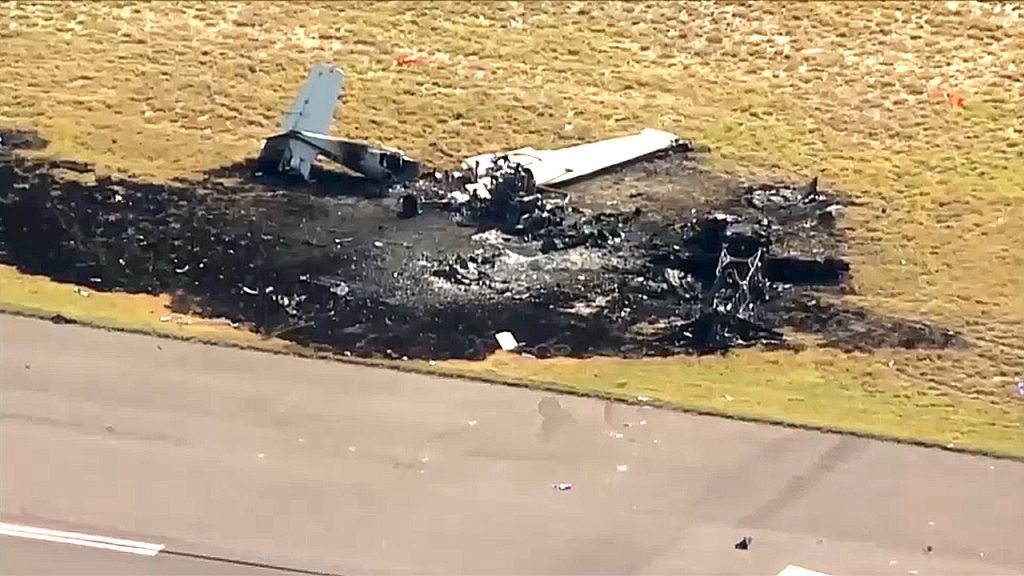Mid-Air Collision Claims Life at Colorado Airport
In a tragic incident that unfolded on a Sunday morning in Colorado, two aircraft collided mid-air near Fort Morgan Municipal Airport, resulting in one fatality and three injuries. The calm of the day was shattered around 10:45 a.m. when witnesses observed two planes clip each other before crashing into fields just outside the airport. According to the Morgan County Sheriff’s Office, a small Cessna was making its final approach to the runway when it was struck by an Extra Flugzeugbau EA300, sending both aircraft plummeting to the ground. The collision left the local aviation community in shock, as this type of accident is relatively rare but always devastating when it occurs. The suddenness of the tragedy underscores the inherent risks of aviation, even in controlled airspace near established airports where flight patterns are typically well-regulated.
As the planes crashed to earth, both immediately caught fire, sending plumes of smoke into the clear Colorado sky. The dramatic scene drew the attention of nearby residents, some of whom rushed to help before emergency personnel arrived. These good Samaritans attempted to extinguish the flames, earning special recognition from the Sheriff’s Office for their courage in the face of danger. First responders arrived quickly to find a harrowing scene – the wreckage of two aircraft and four people in varying states of distress. Their swift actions likely prevented further tragedy, as aviation fuel fires can spread rapidly and pose extreme dangers. The human instinct to help in such situations reflects the close-knit nature of many rural communities, where neighbors don’t hesitate to assist each other in times of crisis.
The human toll of the accident became immediately apparent as emergency crews assessed the victims. The two occupants of the Cessna were fortunate, suffering only minor injuries that were treated at the scene before they were released. However, the outcome was far more grim for those in the Extra Flugzeugbau EA300 – one person was rushed to a local hospital while the other, tragically, was pronounced dead at the scene by the Morgan County Coroner’s Office. Behind these sparse details lie profound personal stories – pilots with years of experience, possibly flight instructors and students, or perhaps friends enjoying a Sunday flight. Each person involved had plans for the day that were violently interrupted, and for one, all future plans were permanently ended. The Sheriff’s Office has withheld the names of those involved while the investigation continues and families are notified, a somber reminder of the human lives behind aviation statistics.
The Federal Aviation Administration confirmed the collision occurred as both aircraft were attempting to land, suggesting a possible communication breakdown or visual misjudgment in the airport traffic pattern. Fort Morgan Municipal Airport, like many smaller regional airports, may not have a control tower directing traffic, leaving pilots to coordinate their movements through radio communication and visual observation. These procedures work remarkably well most of the time, but they aren’t failproof, especially when multiple aircraft are approaching from different directions. The FAA will work alongside the National Transportation Safety Board (NTSB), with the latter taking the lead role in determining what went wrong. This investigation will likely examine factors such as radio communications, weather conditions, pilot experience, aircraft maintenance records, and approach procedures at the airport.
The NTSB investigation will be methodical and thorough, potentially taking months to complete. Investigators will piece together the final moments before the collision, analyzing any available radar data, interviewing survivors and witnesses, and examining the wreckage for clues. Their findings will eventually be published in a detailed report that not only explains what happened but also makes recommendations to prevent similar tragedies in the future. Such investigations have historically led to significant improvements in aviation safety protocols, equipment standards, and pilot training. While this process unfolds, the local community and aviation enthusiasts around the country will follow developments closely, hoping for answers that might bring some measure of closure to those affected and lessons that might save lives in the future.
In their Facebook post addressing the incident, the Morgan County Sheriff’s Office expressed heartfelt condolences to the family and friends of the deceased, acknowledging the profound loss suffered. These words, though formal, hint at the emotional aftermath that extends far beyond the crash site. For the family who lost a loved one, life has irreversibly changed. For the survivors, the physical recovery may be accompanied by psychological trauma that could last for years. The witnesses who saw the collision will carry those images with them. Even the first responders, trained to handle emergencies, must process the emotional weight of what they encountered that day. Community support will be crucial in the days ahead, as Fort Morgan residents rally around those affected by this tragedy. While the investigation proceeds and experts analyze what went wrong in technical terms, the human dimension of this accident – the grief, the trauma, the healing, and eventually the lessons learned – will continue to unfold in ways that statistics and official reports can never fully capture.


